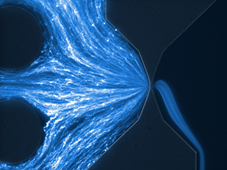October 1, 2020 – How does Spectradyne’s nCS1 measure concentration?
Spectradyne’s nCS1TM uses Microfluidic Resistive Pulse Sensing (MRPS) for detecting particles and measuring their concentration as a function of particle diameter. MRPS is a modern and microfluidic implementation of the Coulter counting method, which has been a gold standard for counting large particles and cells in the clinic for decades.
MRPS works in a simple and very straightforward way:
- The undiluted analyte is flowed through a measurement constriction (see figure to right)
- Every particle over a well-defined size threshold is counted as it passes through the constriction
- For each particle, the flow rate of sample volume is measured
Voila! That is all you need to calculate concentration as directly as possible: Divide the number of particles measured by the sample volume, also measured:

Since the volume flow rate is measured every time a particle is detected:
- Flow rate is measured continuously, often thousands of times per measurement
- Any variations in flow rate over time are accounted for
- Viscous samples are be measured equally well
Microfluidics offers additional important advantages:
- The fixed-size sensing constriction and other fluidic structures are fabricated using high precision manufacturing techniques developed for the semiconductor industry — repeatable geometry ensures consistent measurements
- Also, microfluidic channels are small! This means only 3 microliters of your precious sample are required for analysis

Fluorescent particles passing through the sensing constriction of a Spectradyne MRPS analysis cartridge. Particles flow from left to right in the image.
Other techniques for measuring particle concentrations make significant assumptions when reporting concentration. For example, Nanoparticle Tracking Analysis (NTA), which uses a microscope to take videos of particles diffusing randomly around, must assume that no particles drift into or out of the field of view or the focal plane during a measurement. In addition, NTA has to be able to ‘see’ the particles to begin with, which is a well-documented challenge. Other imaging technologies require immobilization of particles on a substrate before detection. Because the diffusion dynamics and affinity for particles to be captured on the imaging surface are complex functions of the sample composition and particle size, these methods can only estimate relative concentration. Dynamic Light Scattering (DLS) is an also-ran that ASTM standards themselves state is not quantitative for concentration at all.
Accurate measurements of concentration are critical for reducing measurement variability and performing well controlled scientific experiments. Listen to two leaders in their field explain why, in this recent webinar. We have also written about this topic many times before (e.g., in this blog post, and in this application note).
Learn how the nCS1’s straightforward and accurate concentration measurements can help your work by sending us a demonstration sample or two!
Please continue to follow our blog as we share insights, technical details, and generally geek-out with you about nanoparticle science!
Email us for more information, or to discuss your particular application directly.